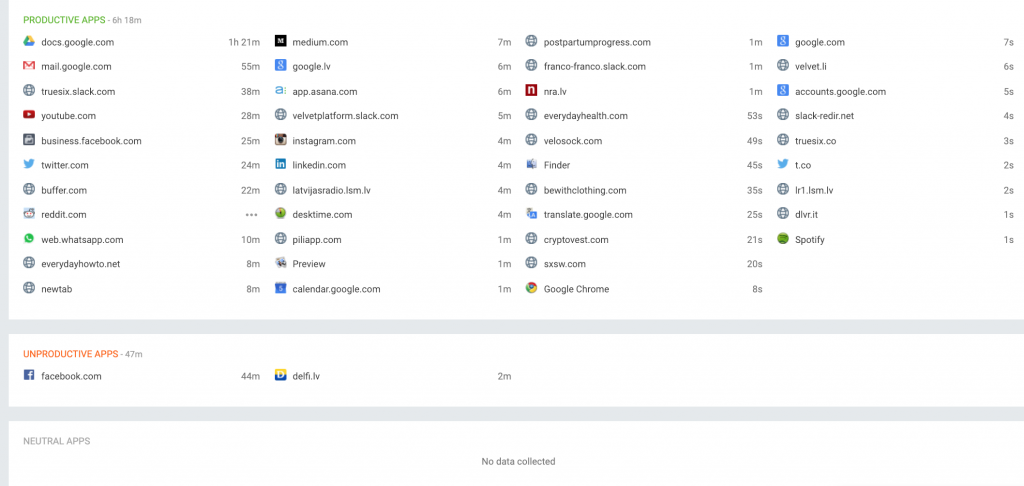How to keep your New Year’s resolutions in 2019

“New year, new me!” – proudly shouted a billion people all across the world, and then promptly kicked their New Year’s resolutions the next day.
But not you. Not today, not tomorrow. You will keep your New Year’s resolutions this year. You will hold yourself accountable. You will take full responsibility for your actions. You will make yourself proud.
Great! Now that you’ve made an irreversible pact to achieve your goals by reading the first few paragraphs of this post – we can start. Keep reading to learn 6 tips on how to keep your New Year’s resolutions (no more hidden irreversible pacts ahead).
Want to get the most out of your time?
Try DeskTime for free!
Try free for 14 days · No credit card required.
By signing up, you agree to our terms and privacy policy.

1. Be a better boss to yourself
How often have you made excuses that you didn’t have the time for or forgot about your newly forming habit? How often have you blamed someone else for pushing their bad influence on you? It’s always someone or something…
Exit blame game. Enter self-control – the one trait you should exercise like a muscle to achieve great success in everything you’ve set to do. Easier said than done? You’re right. Or are you wrong? Or maybe you’re just not doing it right?
A recent study examined how self-control works in practice. Researchers proposed self-control to have a battery or snowball effect like properties, where one suggests self-control can be drained like a battery and other suggests it can spin off and become stronger as used, similarly to a snowball.
The study concluded in findings that self-control is the mix of both. Meaning that displaying self-control once makes it easier to do so again a short time later. However, overdoing it initially makes us more likely to give up altogether.
So be a better boss to yourself, don’t over-control your actions but do keep in mind your goal and work on it. After all, it’s you, not Netflix, who wants to read more books in 2019.

2. Break down goals into smaller tasks
You won’t succeed in fulfilling your NY’s resolutions if you keep focusing on the end result. Instead, direct your energy into dividing your big picture goal into smaller, achievable tasks.
Shape your goals keeping in mind the SMART principle, define them to be:
- Specific – what exactly do you want to achieve?
- Measurable – how will you know when it’s accomplished?
- Attainable – is your goal actually doable?
- Relevant – how will this short-term goal help you reach your long-term goal?
- Timely – how much time do you need to make it happen?
Let’s say your goal for this year is to be more active. Redefining it by the SMART principle would look like so:
- Specific – I will walk 10,000 steps in total at least 5 days per week.
- Measurable – I will use my smartwatch to track my daily steps.
- Attainable – I usually walk 8,000 each day, so an additional 2,000 will be achievable.
- Relevant – I will fulfill my goal of being more active if I take more walks.
- Timely – I will walk 10,000 steps at least 5 days per week until the end of 2019.
This form of goal setting will provide you with structure and guidance throughout the completion of your NY’s resolution. And once you start ticking off your short-term goals, you’ll receive a sense of accomplishment and really start seeing progress towards your end goal.
3. Keep track of your success
Usually, there are two types of people who’d highly benefit from time management – the busy bee and the laid-back star.
The busy bees are always super active, but they often lack in prioritizing. These types of people will benefit from time management in order to actually get the important things done.
Contrarily, the laid-back stars have plenty of time on their hands. They usually plan in so much to do in theory but don’t take real action and procrastinate. If you consider yourself a laid-back star, then make use of time management apps to actually plan your day and get things done.
Shape your days to schedule in quality time for your goals. Use a calendar or journal to plan your actions for the coming weeks. Time tracking software like DeskTime can help with productivity tracking.

DeskTime lets you know if you’re spending time on unnecessary tasks so you can make room for goals that are important to you. Maybe this will be the wake-up call for you to switch that 15-minute funny cat compilation video to a refreshing 15-minute book reading session. Or, vice versa, – if your NY’s goal is watching more cat videos. No judgment.
4. Be accountable
It’s much easier to work towards a goal when you’re not alone. And, it’s more efficient because you’re less likely to allow yourself to let down your accountability partner.
American Society of Training and Development (ASTD) conducted a study on accountability and found that:
- you have a 65% chance of completing a goal if you commit to someone;
- but a success rate of up to 95% if you have a specific accountability appointment with a person you’ve committed with.
So choose your accountability partner and get going! Your accountability partner can be anyone from your child or spouse to even a work colleague or a support group.
Make time one day every week or month to meet up with your accountability partner or group. Discuss the short-term goals you’ve achieved and set new goals to pursue.

5. Fake it till you make it
Starting something new almost never feels natural. You’re just outside your comfort zone and maybe even feel like you’re forcing something on yourself.
If your this year’s resolution is going out more but you’ve been a veteran couch-potato for years, then don’t expect feeling like a fish in the water at the next party you’ll be attending. It will take you a long time to become comfortable at social events. After all, you’re forming a new habit.
Researchers from University College London conducted a study on habit forming and examined 96 people over the space of 12 weeks. The study concluded the average time to form a new habit to be 66 days. In addition, the shortest time for someone to form a habit was 18 days, the longest – 254 days.
So the takeaway message here is that it will take time and patience to really ‘become one’ with your NY’s resolution.
6. Don’t give up – no matter what
This is the time to be true to yourself and acknowledge that a slip-up is almost inevitable at some point. You know it, we know it, everyone knows it. BUT! You must promise yourself not to let it become an excuse to give up.
Albert Einstein once said, “Life is like riding a bicycle. To keep your balance, you must keep moving.”
So when that moment of fallout happens, kick in the self-esteem and get back on your track. Remember all your past achievements, don’t become critical of yourself, feel proud of what you’ve done before your slip-up and move on!
In closing
Cheers to you for making a New Year’s resolution! It takes a lot of courage to make such a broad statement and working on fulfilling it throughout the year. We hope this guide on how to keep your NY’s resolutions will benefit you in the journey of becoming a better, more happier and self-accomplished version of you.
Get going, and good luck!

This article was written by Una Savčenko, a freelance copywriter, storyteller, and improviser. She’s a real wizardess when it comes to creating fun and engaging copies.
Did you find this article useful? Give it a clap!
Psst! You can clap more than once if you really loved it 🙂